| | Water erosion | Wind erosion | Tillage erosion
Soil erosion is the removal of soil by wind, water or tillage. Erosion removes the topsoil, the most productive portion of the soil, reducing levels of organic matter and nutrients, and resulting in lower productivity. Eroded soil particles can reduce water quality and air quality. As well, eroded soil can include soil-attached pesticides and nutrients that further decrease water and air quality (see Water Quality and Air Quality).
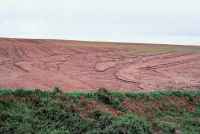 |
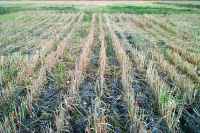 |
Bare soils are vulnerable to erosion.
Courtesy of ARD | Crop residue protects the soil.
Courtesy of ARD |
Water Erosion
Water running over the surface of the soil, called runoff, can pick up, carry and deposit soil particles. Water erosion removes topsoil, reducing soil quality and contributing to lower crop yields. If the eroded particles are carried to a water body, they can degrade water quality and harm the aquatic habitat.
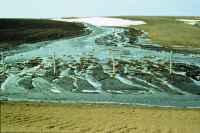
Water erosion removes topsoil, reducing soil quality.
Courtesy of ARD
Factors affecting the risk of water erosion:
- Soil covered by plants or plant residues is less susceptible to water erosion than bare soil. Growing plants and a crop residue cover absorb the energy of raindrops and slow the flow of runoff, reducing the risk of erosion. Roots hold soil in place and contribute organic matter, which further stabilizes the soil.
- The greater the amount and intensity of snowmelt or rainfall, the greater the risk of water erosion.
- Steep and/or long, uninterrupted slopes are especially prone to erosion because water can pick up speed as it travels downslope.
- Fine- to medium-textured soils (Figure 2.2), especially clays and silts low in organic matter, are very prone to water erosion.
- Sometimes clayey and silty soils can be prone to crusting. Crusting reduces water infiltration (the movement of water into the ground). Less infiltration means more runoff and a greater risk of water erosion.
- Soils with a shallow, impermeable layer (hardpan layer) are more prone to erosion because this layer limits infiltration deeper into the soil.
- Tillage leaves the soil prone to water erosion by decreasing the size and stability of aggregates, thus decreasing infiltration, and by burying the crop residue cover.
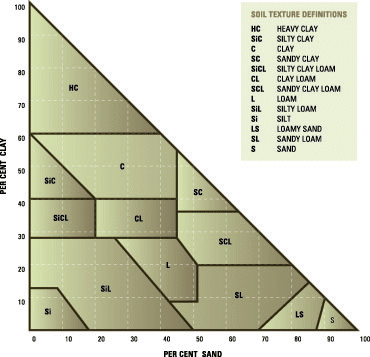
Figure 2.2. Soil texture
Adapted from: Agriculture and Agri-Food Canada and Ontario Ministry of Agriculture and Food. 1997.
Best Management Practices: Soil Management. Agriculture and Agri-Food Canada and Ontario Ministry of Agriculture and Food. p. 8.
Wind Erosion
Soil particles can be picked up, carried and deposited by the wind. Wind erosion removes the topsoil, resulting in less productive soil and lower crop yields. It tends to carry away the smaller particles leaving the larger particles behind. The visible effects of wind erosion include soil deposited along fence lines and in ditches, blackened snowdrifts and eroded knolls.
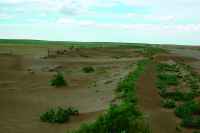
Visible effects of wind erosion include soil deposited along fence lines and in ditches.
Courtesy of ARD
Factors affecting the risk of wind erosion:
- Smaller soil particles are easier to erode than larger ones.
- Organic matter helps hold soil particles together in soil aggregates; these aggregates are harder for the wind to move than small individual soil particles.
- A cover of plants or plant residues prevents wind erosion.
- High wind speeds and persistent winds have more erosive power.
- Wind barriers, such as shelterbelts and wooded areas, reduce wind speeds and the risk of wind erosion (see Shelterbelts).
- Dry soils are more susceptible to wind erosion.
- Tillage leaves the soil prone to wind erosion by burying crop residues, drying out the soil, decreasing soil organic matter and decreasing soil aggregate size.
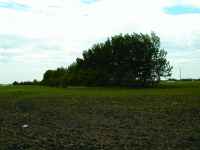
Shelterbelts reduce wind erosion.
Courtesy of Agriculture and Agri-Food Canada - PFRA
Tillage Erosion
Tillage erosion is the downslope movement of soil by gravity with tillage operations (Figure 2.3). Tillage erosion increases with more tillage passes and greater tillage intensity. It redistributes soil within the field, resulting in topsoil losses on hills and knolls, and accumulations in low areas.
Figure 2.3. Tillage erosion
Adapted from: Agriculture and Agri-Food Canada and Ontario Ministry of Agriculture and Food. 1997.
Best Management Practices: Soil Management. Agriculture and Agri-Food Canada and Ontario Ministry of Agriculture and Food. p. 46-47.
Factors affecting the risk of tillage erosion:
- More tillage passes and more intense tillage increase the risk of tillage erosion.
- Use of tillage and seeding implements that cause very little soil disturbance reduces the risk of tillage erosion.
- The risk of tillage erosion is greater on steeper slopes.
Back to Chapter 2 - Environmental Considerations |
|